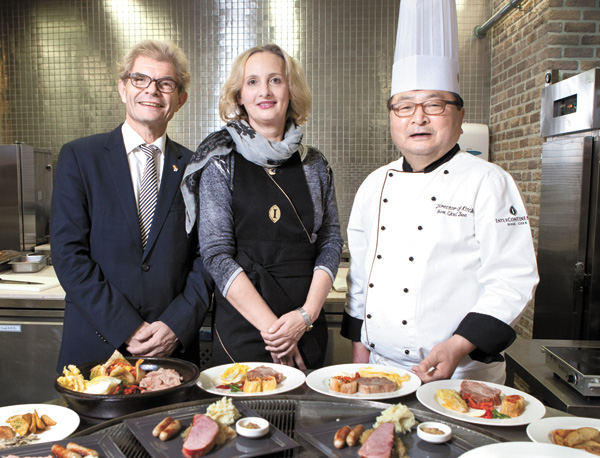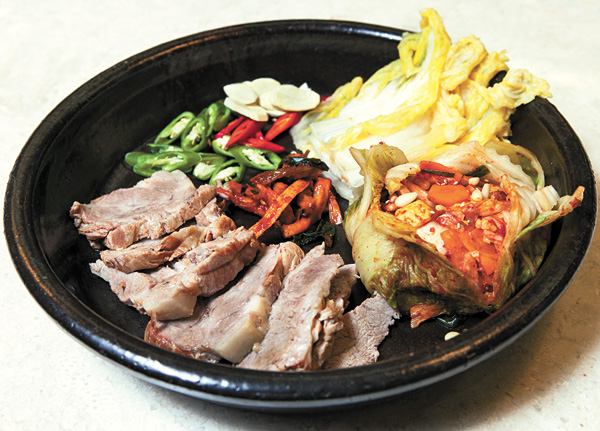[Cooking with Her Excellency, Germany] After time in Germany, chef sees similar tastes

German Ambassador Rolf Mafael, his wife Christina and executive chef Bae Han-chul By Park Sang-moon
A. Holding with the theme of pork, I thought of a dish that can be enjoyed for the taste of the fresh meat itself without being dependent on spices or seasoning.
You have a long history with cooking German food. What do you think of this German dish?
I trained under a German senior chef for nine years in 1999, and later an Austrian chef. I also have experience working at a sausage factory for 40 days in the German town of Aschaffenburg.

How do you think bossam is similar to the German dishes prepared today?
I think that preparing pork in a large portion is very similar to the kassler [smoked pork], more than any other dish. Jagerschnitzel is like donkatsu [Korean- and Japanese-style pork cutlet]. Sauerkraut can be like kimchi. Korean may evoke when thinking of German cuisine.
What other Korean food items do you think would go with the German pork dishes?
German schweinshaxen [pork shank] goes very well with Korea’s white kimchi.
Bossam (boiled pork) with geotjeori (fresh kimchi salad)
Bossam
1.2 kilograms (2.6 pounds) of pork neck
50 milliliters (1/4 cup) soy sauce
20 grams (4 teaspoons) cooking wine
100 grams (1 cup) fresh ginger
10 cloves of garlic
1 large scallion
1 onion
200 grams (2 cups) doenjang (fermented soy bean paste)
Geotjeori
200 grams (2 cups) roughly chopped cabbage,
50 grams (1/4 cup) chives
20 grams (4 teaspoons) green or red pepper
30 grams (1/8 cup) of raw peeled chestnuts
30 grams (2 tablespoons) red pepper flakes
20 grams (4 teaspoons) kanari (sand lance) fish sauce
Roasted sesame seeds Salt
Sesame oil Pine nuts for garnish
Bossam
1. Clean the pork neck, parboil in water and drain.
2. Place pork in a medium-to-large pot and add soy sauce, cooking wine, garlic, scallion, onion, doenjang and water until the pork is completely submerged. Boil for about an hour. As the liquid condenses down to expose the meat, add more water until pork is covered again.
3. Take out pork when tender and slice into desired width.
Geotjeori
1. Dissolve salt in water in a one-to-five ratio. Soak cabbage for five minutes
2. Mix cut cabbage with remaining ingredients in a bowl.
3. Serve with pork.










with the Korea JoongAng Daily
To write comments, please log in to one of the accounts.
Standards Board Policy (0/250자)